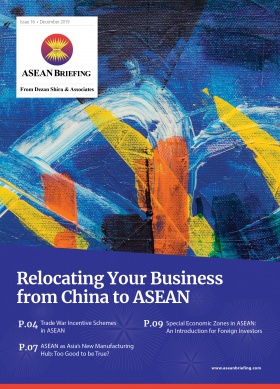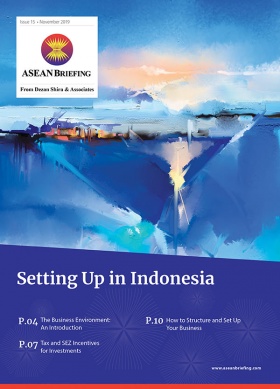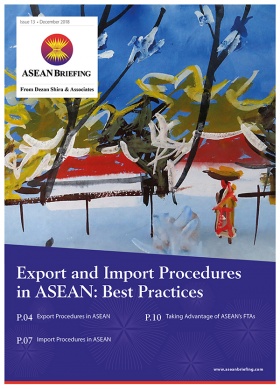The RCEP: Impacting ASEAN’s Supply Chains and Business Environment
- The Regional Comprehensive Economic Partnership (RCEP) is set to be formally signed in 2020.
- The free trade agreement could impact ASEAN through the lowering of trade barriers and the expansion of market access for goods and services.
- Analysts have noted that the agreement could accelerate Chinese influence, but the ASEAN Centrality document hopes to keep this in check.
The Association of Southeast Asian Nations (ASEAN) has been pursuing the finalization of the Regional Comprehensive Economic Partnership (RCEP) in what is set to be the world’s largest free trade agreement (FTA).
The latest rounds of negotiations were held on November 4, 2019, at the third RCEP Summit in Bangkok. During these recent talks, 15 out of the 16 nations involved concluded ‘text-based’ negotiations, with a formal signing expected to be completed in 2020.
The impetus to strike a trade deal has grown more urgently for ASEAN as its members grapple with the economic impact of the US-China trade war. As protection against protectionism, the RCEP can be beneficial for countries seeking to stabilize their economies amidst this ongoing uncertainty.RCEP overview
Initiated by ASEAN in 2012, the RCEP’s conclusion would cement the ASEAN bloc’s pivotal role in forging regional integration. The proposed free trade agreement would link together ASEAN countries and their six FTA partners – China, Japan, South Korea, Australia, New Zealand, and India. However, India recently abstained from joining the RCEP citing fears that its markets could be flooded with Chinese consumer goods as well as agricultural products from New Zealand and Australia.
The RCEP was devised as a forward-looking trade deal. In contrast to the World Trade Organization (WTO) rules, the agreement balances a mix of ‘WTO-plus’ commitments to lower at-the-border trade barriers and ‘WTO-extra’ provisions to address behind-the-border regulatory issues. As such, the agreement aims to achieve a comprehensive economic partnership that covers wide-ranging issues such as trade, investments, technological cooperation, intellectual property rights, competition, e-commerce, and dispute settlements, amongst others.
Impact on trade and supply chains in ASEAN
ASEAN currently has multiple ‘plus-one’ trade agreements with its FTA partners. In order to provide concrete market access and investment commitments, the RCEP will simplify rules and procedures for each FTA within a single arrangement and reduce existing trade inefficiencies. This solves the so-called ‘noodle bowl’ problem of ASEAN becoming entangled with multiple FTAs and different rules for each country.
The RCEP has the potential to bring significant opportunities for participating countries as it is set to encompass about 45 percent of the world’s population (3.4 billion) and a third of global domestic product (GDP) (about US$20 trillion). Furthermore, the bloc accounts for total trade of US$10 trillion and 26 percent of foreign direct investment (FDI) flows.
The RCEP will lower trade barriers and improve market access for goods and services, attracting foreign companies keen on entering into a more integrated ASEAN. This will enhance transparency in trade and investment, as well as facilitate the greater inclusion of ASEAN’s small and medium-sized enterprises (SMEs) to global and regional supply chains — according to the ASEAN Secretariat, SMEs in ASEAN employ between 52 and 97 percent of all workers.
Likewise, technical cooperation with advanced industrialized countries like Japan, South Korea, New Zealand, and Australia will assist ASEAN SMEs in developing better, more competitive products – the telecommunication services and agriculture industry are likely to boom with businesses competing regionally.Southeast Asia has also one of the highest intra-industry trade — the trade of similar products belonging to the same industry— in the world, mainly attributed to its thriving electronic sector and its well-established supply chains. The RCEP will boost this trend due to the reduction of tariffs and the application of new innovations that increase the value-added contents of local products.
How does the RCEP benefit ASEAN countries?
Singapore
This deepened integration is set to benefit Singapore as a pivotal player in regional trade and supply chains in ASEAN. However, the RCEP is unlikely to add much to Singapore’s trade numbers in the short-term. The country already has bilateral agreements with all the non-ASEAN partners, namely Japan, South Korea, Australia, New Zealand, and China. Additionally, any meaningful tariff reductions for major export items are likely to be implemented in phases over a period of years, again unlikely to boost exports in the short term.
Thailand
Thailand – whose export shipments account for 70 percent of its GDP – can benefit from the RCEP through greater integration of its economy with supply chains and larger markets in the Asia-Pacific. Thai exporters can benefit in terms of trade, price value, and innovation, and manufacturers can also obtain cheaper raw materials from a larger net of sources.
The Philippines
The RCEP would open markets for 92 percent of products produced by the Philippines. This includes the business process outsourcing industry. Additionally, service workers in the Philippines, such as seafarers, teachers, IT programmers, and engineers can benefit due to demand from countries like Japan and South Korea which are in need of service workers.
Indonesia
Similarly, Indonesia – the largest economy in ASEAN – will benefit from an increase in market access, investment, and opportunities to participate in regional supply chains. In turn, these advancements will lead to an increase in exports which is critical for the country’s economic growth. Amidst the US-China trade war, the government has made it a priority to complete various trade deals with countries and organizations to boost its exports.
Malaysia
A large majority of Malaysia’s trade is with RCEP members, and the agreement will provide Malaysian companies and consumers with increased commercial opportunities and partnerships. Companies specialising in industries like telecommunications, banking and finance, and consultancy will benefit from enhanced cooperation. Malaysian businesses will also enjoy better access to quality raw materials at competitive prices.
Vietnam
The RCEP would give Vietnamese enterprises the chance to boost exports, engage in new value chains, and attract further foreign investment. The cutting of import tariffs would open up new opportunities for products from its prominent sectors like telecommunications, ICT, textiles and footwear, and agriculture – all of which are continually growing with rising export turnovers.
Smaller ASEAN economies
The agreement could also facilitate smaller ASEAN economies – Laos, Myanmar, Brunei, Cambodia – to further strengthen their FTAs, and decrease the development gap between ASEAN members.
Changing the regional landscape for business
Ultimately, without the finalized text available, it is impossible to know the extent to which the region will transform as a result of the RCEP. It remains to be seen whether the RCEP will lead to a rule-based trading system that generates more equitable and deeper trade – acting as a precursor to a single market – or will merely be a modest upgrade to existing agreements.
Likewise, it is unclear if the RCEP will align with the intentions of ASEAN or if it will alternatively accelerate the Sinification – the increasing spread of Chinese influence – of Southeast and East Asia. So far, the RCEP has been an ASEAN-led project and the group’s ‘Guiding Principles and Objectives for Negotiating the Regional Comprehensive Economic Partnership’ principle reiterates the recognition of ‘ASEAN Centrality’ during the negotiation process.
However, if the RCEP rules and processes are not stringent enough, it could bring countries further into China’s orbit, provide China with significant negotiating leverage over its partners, and facilitate China and its state-owned enterprises (SOEs) a hegemonic position in regional trade.
China alone has already emerged as ASEAN’s biggest trading partner. Its total trade has grown at an average of 10 percent per year since 2009, and reached US$483 billion in value in 2018.
India’s decision to not participate will be another factor affecting the possible Sino-centric nature of the RCEP, as the exit of 1.3 billion people could boost China’s influence – a prospect other members do not want. India’s absence will also diminish ASEAN’s aspirations to expand into the Indo-Pacific region.
About Us
ASEAN Briefing is produced by Dezan Shira & Associates. The firm assists foreign investors throughout Asia and maintains offices throughout ASEAN, including in Singapore, Hanoi, Ho Chi Minh City and Jakarta. Please contact us at asia@dezshira.com or visit our website at www.dezshira.com.







